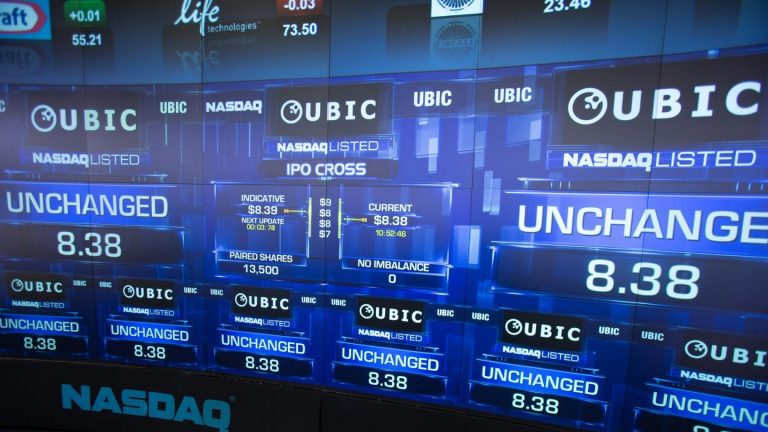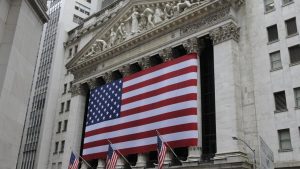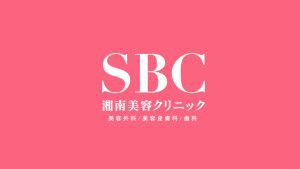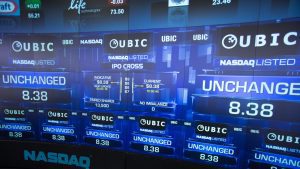(C)2013, The NASDAQ OMX Group, Inc.
In August 2013, the listing ceremony for UBIC, Inc. (now FRONTEO, Inc.) was held at the Nasdaq MarketSite in New York’s Times Square, where the “Closing Bell” was rung to symbolize the listing. UBIC had officially listed in May of that year. This was the first Nasdaq listing by a Japanese company in 14 years. UBIC’s listing was met with surprise among market participants and served as a catalyst, reviving interest in Nasdaq listings among Japanese companies.
Nasdaq: Home to the World’s Largest Company by Market Cap
Nasdaq, alongside the NYSE, is one of the world’s largest securities exchanges. It has approximately 3,000 listed companies (compared to ~2,400 for NYSE and ~3,600 for TSE). As of the end of April 2018, its total market capitalization was approximately 1,000 trillion JPY (approx. $10T), making it the second-largest exchange in the world (NYSE ~2,000T JPY; TSE ~680T JPY).
While its total market capitalization does not match the NYSE, when looking at individual companies (as of the end of May 2018), the world’s largest company by market cap, Apple, is a Nasdaq-listed company. The 2nd largest, Amazon.com; 3rd, Microsoft; 4th, Alphabet (Google); and 5th, Facebook, are all listed on Nasdaq. The top five companies in the world by market capitalization are all Nasdaq-listed.
Top 10 Global Companies by Market Cap & Stock Exchange (As of end of May 2018)
| Company Name | Market Cap ($B) | Stock Exchange | |
| 1 | Apple | 918 | Nasdaq |
| 2 | Amazon.com | 790 | Nasdaq |
| 3 | Microsoft | 759 | Nasdaq |
| 4 | Alphabet (Google) | 758 | Nasdaq |
| 5 | 555 | Nasdaq | |
| 6 | Alibaba Group Holding | 500 | NYSE |
| 7 | Tencent Holdings | 493 | NYSE、HKSE |
| 8 | Berkshire Hathaway | 472 | NYSE |
| 9 | JPMorgan Chase | 364 | NYSE |
| 10 | Exxon Mobil | 343 | NYSE |
Nasdaq may have an image as an emerging market for startup ventures. While it is true that it possesses functions and aspects of an emerging market, in reality, it is not just home to emerging companies; the giant corporations driving global technology are listed on Nasdaq.
Nasdaq: Originally a De Facto OTC Market
Nasdaq was launched on February 8, 1971, as the world’s first electronic securities market. The name “Nasdaq” is an acronym for the National Association of Securities Dealers Automated Quotations. As the name implies, it was a system for the automated reporting of OTC (over-the-counter) stock price quotations, built by the National Association of Securities Dealers (NASD), a self-regulatory organization originally established to monitor and operate OTC trading.
Although Nasdaq was a “stock market” using this automated quotation system, it was not a “securities exchange” (specifically, a “national securities exchange” as defined by law). Therefore, at least in its early days, it functioned as and was recognized as an over-the-counter (OTC) market. For example, in publications such as newspapers and Standard & Poor’s reports from the 1970s through the early 1980s, Nasdaq stocks were reportedly treated as OTC stocks, not “listed” stocks.
Among Japanese companies, there were some whose ADRs were traded on Nasdaq from its inception. Specifically, eight companies: Canon, Fujifilm, JAL, Tokio Marine & Fire, NEC, Nissan, Toyota, and Mitsui & Co. Later in the 1970s, others like Kirin, Daiei, Wacoal, Makita, Sanyo Electric, and Shiseido joined Nasdaq.
According to Nasdaq data, there are indications that securities of other companies like Honda, Kyocera, Kansai Electric Power, Pioneer, Kenwood, TDK, and Toshiba were also traded in the 1970s. However, it is extremely difficult to precisely identify or confirm which companies’ securities were traded on Nasdaq in its early days. Our firm also attempted this research but could not confirm the factual relationships. To explain the reason, one must understand how Nasdaq was positioned legally and under the rules.
Nasdaq’s Early Days: SEC Registration Not Required for Japanese Companies
Nasdaq was launched on February 8, 1971, as the world’s first electronic securities market. The name “Nasdaq” is an acronym for the National Association of Securities Dealers Automated Quotations. As the name implies, it was a system for the automated reporting of OTC (over-the-counter) stock price quotations, built by the National Association of Securities Dealers (NASD), a self-regulatory organization originally established to monitor and operate OTC trading.
Although Nasdaq was a “stock market” using this automated quotation system, it was not a “securities exchange” (specifically, a “national securities exchange” as defined by law). Therefore, at least in its early days, it functioned as and was recognized as an over-the-counter (OTC) market. For example, in publications such as newspapers and Standard & Poor’s reports from the 1970s through the early 1980s, Nasdaq stocks were reportedly treated as OTC stocks, not “listed” stocks.
Among Japanese companies, there were some whose ADRs were traded on Nasdaq from its inception. Specifically, eight companies: Canon, Fujifilm, JAL, Tokio Marine & Fire, NEC, Nissan, Toyota, and Mitsui & Co. Later in the 1970s, others like Kirin, Daiei, Wacoal, Makita, Sanyo Electric, and Shiseido joined Nasdaq.
According to Nasdaq data, there are indications that securities of other companies like Honda, Kyocera, Kansai Electric Power, Pioneer, Kenwood, TDK, and Toshiba were also traded in the 1970s. However, it is extremely difficult to precisely identify or confirm which companies’ securities were traded on Nasdaq in its early days. Our firm also attempted this research but could not confirm the factual relationships. To explain the reason, one must understand how Nasdaq was positioned legally and under the rules.
Nasdaq’s Early Days: SEC Registration Not Required for Japanese Companies
The idea that it’s difficult to know which companies were on Nasdaq is unbelievable to those familiar with it today. To understand this, one must delve into the technical aspects of the laws and rules related to the U.S. securities market.
U.S. securities regulations are built on the Securities Act of 1933 (the “Securities Act”) and the Securities Exchange Act of 1934 (the “Exchange Act”). When these laws were enacted, the U.S. Securities and Exchange Commission (SEC) was established in 1934 to administer and oversee them. As a result, in the U.S., issuers of securities listed on a “national securities exchange” (specifically, an exchange registered with the SEC under Section 6 of the Exchange Act) were required to register with the SEC.
However, this SEC registration was only required for companies listed on a national securities exchange; over-the-counter (OTC) stocks, such as “pink sheets,” had no SEC registration or continuous disclosure obligations. As the trading volume in the OTC market grew, the gap in the level of information disclosure between listed companies and OTC companies (of which there were said to be ~3,500 in 1963[i]) became a concern.
Consequently, the Securities Acts were amended in 1964, establishing Section 12(g) of the Exchange Act. This Section 12(g) mandated that even unlisted companies traded OTC must register with the SEC (and fulfill continuous disclosure obligations) if they exceeded a certain external threshold, specifically $1 million in total assets and 500 or more shareholders[ii] (at the time).
However, there were concerns about imposing this asset-and-shareholder-based registration requirement on foreign private issuers (FPIs). When the Exchange Act was amended, an exception for FPIs was permitted, and in 1967, Exchange Act Rule 12g3-2 was established. This rule exempted FPIs, including Japanese companies, from the SEC registration and continuous disclosure obligations under Exchange Act Section 12(g), provided they met certain conditions.
Nasdaq was launched in 1971. Because Nasdaq was not a national securities exchange, trading on it did not constitute a “listing” under the Securities Act or Exchange Act. Therefore, (Section 12(b)) registration with the SEC was not required.
While Section 12(g) was already enacted by 1971 (requiring U.S. companies meeting the external threshold to register), FPIs were exempted from Section 12(g) registration by Rule 12g3-2. Therefore, Japanese companies did not need to register with the SEC even if their securities were traded on Nasdaq. As a result, most Japanese companies whose ADRs were traded on Nasdaq in the 1970s were not required to register with the SEC, and in fact, did not.
Furthermore, separate from the Securities Act and Exchange Act, under Nasdaq’s rules at its inception, it was possible for a securities firm to register a company’s stock (ADR) on Nasdaq without the issuer’s consent. Consequently, there were many cases, such as with Fujifilm and JAL, where companies found themselves on Nasdaq without their knowledge or intent.
Thus, Nasdaq in the 1970s was institutionally immature and seems to have been fraught with various contradictions. However, the trading system it provided was becoming indispensable to the securities market, and trading on the Nasdaq market continued to expand. As Nasdaq matured as an exchange, the SEC began to view this situation as problematic.
The details are unclear, but by 1983 at the latest, it was no longer possible to trade a company’s securities on Nasdaq without the issuer’s consent[iii]. (This is complete speculation, but Nasdaq records show that Honda, Kansai Electric Power, Kyocera, Matsushita Electric, Pioneer, and Toshiba all ceased trading on November 22, 1981, which may be when this rule changed.)
A further turning point was the revision of Rule 12g3-2, issued by the SEC on October 5, 1983. From this day forward, the very nature of what it meant for a Japanese company to have its stock (ADR) traded on Nasdaq changed completely.
[i] RICHARD M. PHILLIPS AND MORGAN SHIPMAN, An Analysis of the Securities Acts Amendments of 1964
[ii] Technically, the threshold was 750 shareholders on a temporary basis until June 1966, and 500 thereafter.
[iii] 83-58 SEC Rule Change Relating to Foreign Securities in NASDAQ
For questions or consultations regarding this page, please feel to contact us using the inquiry form below.









